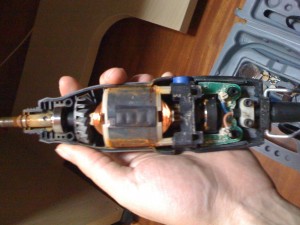Past year winter was very rainy here were I live. So rainy that I had the groundfloor of the house where I live flooded, garage included.
Big mess everywhere, but luckily, my room (I live with other people, we share the apartment) is on first floor of the house, so most of my stuff was
safe.
The only mine thing that gone underwater was my Dremel 300 drill. This not-so-lucky piece of engineering did a 15 hours long bath into muddy waters. After the flood, I was too busy cleaning the house and putting pieces back in place, so I forgot to take a look on my poorly wet Dremel.
Until today! I remembered about his existance because I needed him to cut in half a printed circuit board.
Great. Where the hell is my Dremel?!
Oh fuck! It has been underwater when the flood occurred! Can it still work? My worries were related to rust formation, due to the fact that the drill
was only shaked a bit to let the water go, but it was not opened up, cleaned and dried.
All my worries gone away when I connected it to the grid and pushed the switch. We have a rotation! Tt’s working, and it’s working good!
Even at full speed, no strange sounds, no buzzes. It worked like a charm.
Curiosity drives me, and I were too curious to see the belly of this little workhorse, so I disassembled it.
Here there are few toughts that I want to share about my little Dremel servicing experience.
Fully KISS compliance (Keep It Simple Stupid):
Too easy to take apart the pieces. No fucking strange screws (like f.e. those unnecessary crappy tri-wings), or sticker-screw-masks. Just plain torx type screws. Nothing is so easy like open up this guy (Okay, don’t take me too serious, man). All the pieces inside where easy to take apart. I was able to
pull out the rotor from the stator in a bunch of minutes. The stator seats on drill enclosure. There is no glue, no strange things. The rotor axle
has two little bearings on the ends, one of them has a little rubber gasket on it. The rotor windings where perfect, magnets was a little rusty, only
on the surface. Rust was also on stator magnets, on the end of the rotor axle (near the drill tip attachment), and on the surface of the bearing without
gasket. There was a thin film of mud everywhere, water was evaporated as expected.
Easy to see how all pieces fits together, was easy to put the pieces back in place.
Quality:
I’m not a materials expert, nor an engineer or a designer, but I had the opportunity to take apart a lot of things in my life; This little drill
rocks. Flood-proof parts here, dude.
Mantenaince:
As said before, there was rust on the surface of magnets. Rust was also on the rotor axle, and on bearings surfaces. Nothing serious, just rust on the
surface that probably get worse if not removed. I choosed to use fine-grained metal sandpaper for rust removal and a sprinkle of WD40 to protect from corrosion. NOTE: Use sandpaper on the windings is probably a bad idea.
Final toughts:
Nice example of industrial design. We need more things engineered like this one. Simple. Cheap. Durable. Easily repairable. Easily serviceable.
We don’t need complicated and impossible to open things, and although the dremel is not open hardware, I think that hardware makers can use it as a good example.
Now put your drill in the air, and start to sing.. “We don’t need no, complications, we don’t need no, control of our hardware….”
NOTE(I don’t work for Dremel, no one paid me to write that toughts)
NOTE2(Someone would pay me for write good things about products? Drop me a mail if interested!)
**Some Links: **
Companies, please respect maker’s bill of rights!!
The Hardware Hacker Manifesto
Wikipedia on open source hardware
